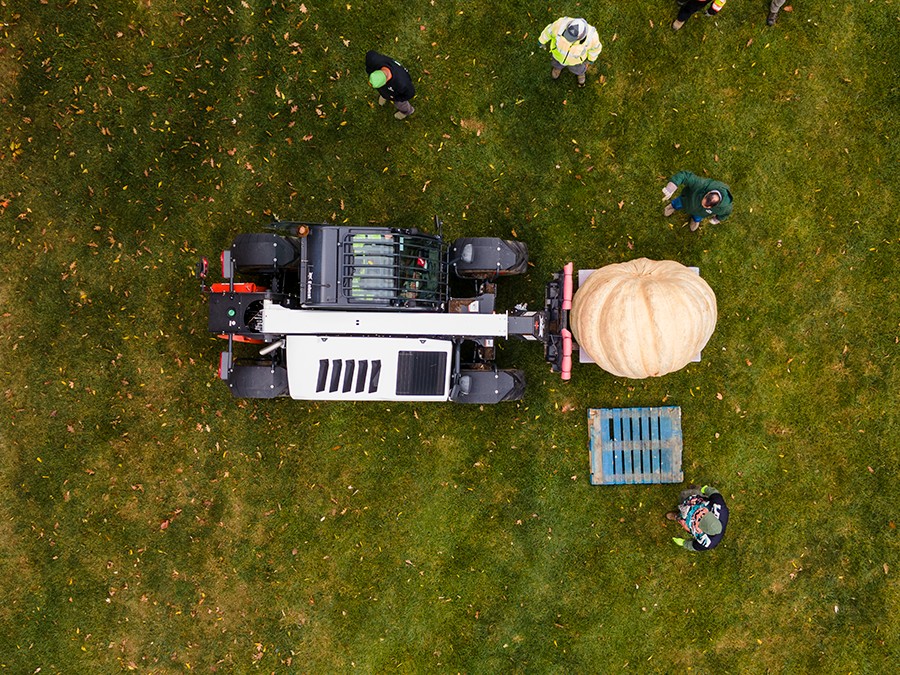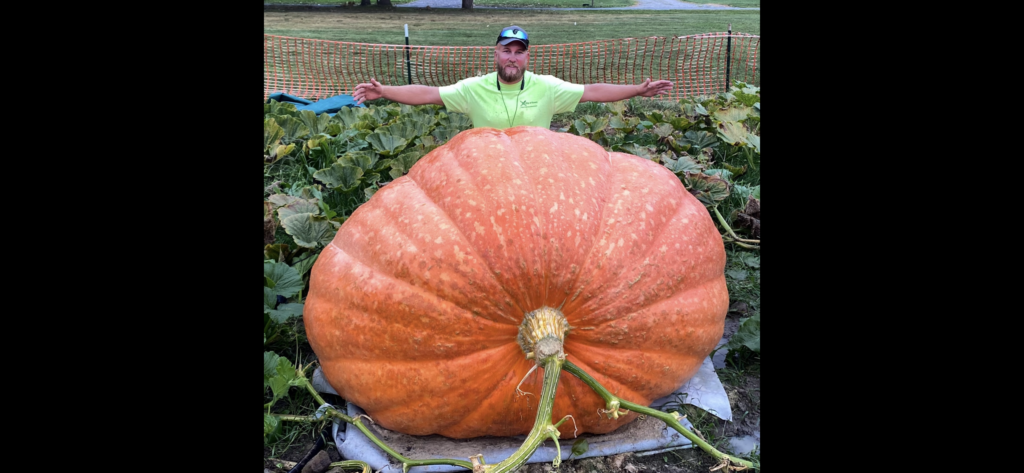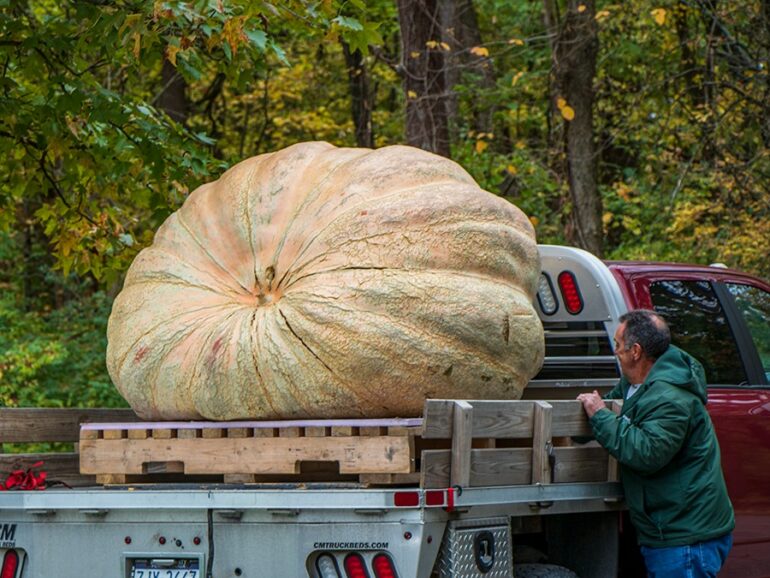Portage County has produced many champions. This year it was the champion of produce.
Doug Kisamore, 30, of Diamond, set the record for the largest pumpkin ever grown in Ohio during an Oct. 8 weigh-off in Canfield.
The Waterloo grad suspects his pumpkin was the 25th largest grown in the world this year, although it was about 500 pounds shy of the all-time world record of 2,702 pounds, set in Italy last year.
Giant pumpkin growing is a robust global subculture. Like any human activity that seeks to harness physics in the pursuit of “more perfect,” pumpkin plumping has its hobbyists and it has its artists. Kisamore is among the latter.
For him, it’s an activity passed from father to son and father to son again. Al Kisamore began the tradition around the time Doug was born. Rick Kisamore continued the pastime and passed it to Doug. It was Rick’s pumpkin that won first prize at this year’s Randolph Fair.
I spoke with Doug Kisamore about his growing and condensed the interview slightly for length. When he’s not working his day job (which often includes night shifts) at the City of Green, he’s usually in his pumpkin patch, coaxing his squash into the record books.

Ben: Forgive me, I’m new to the world of enormous pumpkins, so let’s start with why do you do this? Do you have like a regular pumpkin farm, or do you just do this? What’s your story?
Doug: No, I don’t have I don’t have a regular farm. My grandfather, Al, he started growing giant pumpkins back in the mid-90s. And so that’s what got me interested in it. And I started doing it in 2019 was the first year I grew one.
Ben: You went from first pumpkin to biggest pumpkin ever in the space of three years. That’s an amazing trajectory.
Doug: First year my pumpkin was 383 pounds. I took it to the Randolph Fair.
Ben: And this one was, what, 2,000-something?
Doug: Twenty-one ninety-five and a half. And the half is important because the old record was 2,195. I beat it by half a pound.
Ben: How do you grow them? Like, what’s the trick of…
Doug: How much time do you got?
Ben: I’ve got as much time as you’ve got.
Doug: I could talk for months.
Ben: It’s not like you just plant a pumpkin seed, or they would all be like this. What goes into this?
Doug: So the main thing it comes down to is good seed, good weather, water, fertilizer, good luck. Any one of them could kill you. You could have a bad year of weather and you’d be hosed, or if you can’t get the seeds. I mean, they sell giant pumpkin seeds at Lowe’s, but if you picked one of those up if you got to 500 pounds you’re doing damn good. Good soil is very important. We’re soil testing a couple times a year.
Ben: What would you say is the difference then between your 383-pound pumpkin and your 2,195-pound pumpkin?
Doug: Well, I did have a good seed first year, but I just didn’t have the knowledge base that I do now. A lot of reading, like weeks of hours researching and reading.
Ben: On Reddit? Or are there books on this? What are you reading?
Doug: There are some websites like the Ohio Valley Giant Pumpkin Growers — that’s where I weighed it and that’s the club I’m a part of. So there’s that, and then another website is bigpumpkins.com, which is like the Facebook for giant pumpkin growers. There are message boards that are talking about everything. It definitely seems like nowadays you see guys that haven’t been growing as long make the rise to growing big pumpkins faster just because of the internet. There’s so much more information out there. And it seems like genetics are getting better. So that is constantly improving the weights of pumpkins.
Ben: Where did the seed for your record-setting one come from?
Doug: It is actually my own seed. It’s from an 872-pound pumpkin that I grew in 2020.

Ben: I noticed on your Facebook page you’d posted a picture of little packets of seeds from what looked like previous pumpkins of yours or maybe of your grandpa’s, I don’t know. Is that what that is? You just harvest the seeds from previous large pumpkins?
Doug: Yes. Yeah, I got all the seeds out of this one — actually just finished drying them. And then I’ll trade them with other growers. Actually, if anyone is interested in trying to grow their own giant pumpkins, I sell them at my website, which is megapumpkins.com.
Ben: So anyone could buy the seeds from this pumpkin?
Doug: Yes, they’re on there. They can buy the seeds from that state record pumpkin tomorrow. I was just doing some germination tests on them, but I don’t anticipate any germination problems and they all look good.
Ben: How many seeds are you able to pull out of there that are fit for planting?
Doug: This one had a good seed count. But really it can vary. My dad had one that had no seeds in it. And sometimes you might only get 10 or 20, but I’ve heard guys getting 6-700 out of one pumpkin.
Ben: Is there anything special that you have at your property that positions you to make state records?
Doug: I do this at my own property over here in Diamond, and… no, there’s not a lot I like about it. Where I grow I’m pretty protected from high winds, which can be an issue — you get a big storm come through and you can snap all the leaves off your plants. But other than that, like, my ground to start with is solid clay. Which is not great to grow anything. So I had to bring in a lot of compost to help break down that clay, and then when I started to get the clay broke down then I can soil test and balance my nutrients from there.
Ben: How do you lift them? How do you transport them and how do you weigh them?
Doug: They call it a lifting ring, but basically I have an 18-inch round circle, half-inch thick steel plate with eight eye bolts coming out of it. So then straps hang down from that. Straps hang down around the sides of the pumpkin and then take a rope or another strap and run through the bottom of all those straps and cinch it up around the bottom so it kind of cradles it and pick it up with a tractor, skid steer, whatever. You just pick it up high enough to get it on a pallet, and then you can use pallet forks to load it on the trailer. And then for weigh-offs, they weigh off scales. My pumpkin club, the Ohio Valley Giant Pumpkin Growers is a part of what’s known as the Great Pumpkin Commonwealth, which is the official overseeing committee of all the big pumpkin stuff. So they’re worldwide and there’s a little over 100 weigh-offs now in the world.
Ben: So the seeds from this one, are these your most genetically promising pumpkins for potentially breaking your own record next year?
Doug: I think. I mean, I’m probably gonna grow it. I grew this year. Man, they’re a lot of work. With four plants, I probably spent 40 hours a week in the pumpkin patch to grow at this level. If somebody’s just trying to grow a 500-pound pumpkin and you’re not trying to compete for state records, you could do it with a lot less time. Another thing if people are reading this and think they might be interested, find the Ohio Valley Giant Pumpkin Growers on Facebook, and every February we have a beginners seminar in Canfield. It’s a couple hours long and teaches all the basics like what you need to know.
Ben: You’re giving fuel to the competition, man. In three years, they’re gonna be gunning for you.
Doug: That’s one thing about giant pumpkin growing: There’s really no secrets. We’re all trying to accomplish the same goal and that’s just grow the biggest pumpkin possible. The sharing of information is really good in the giant pumpkin world, because everyone just wants to grow the biggest pumpkins. And even though you’re competing against each other like, yeah, I want to see you grow a 3,000-pounder.
Ben Wolford is the editor and publisher of The Portager.
[email protected]
330-249-1338


